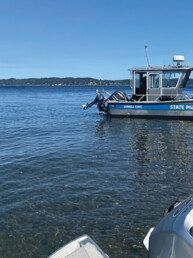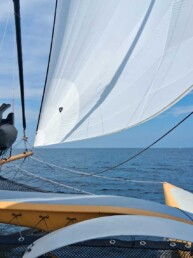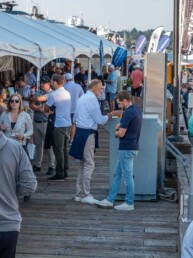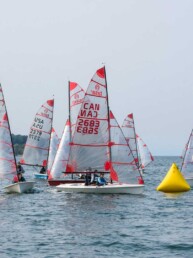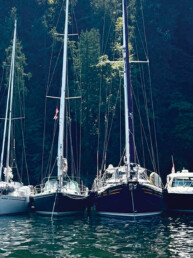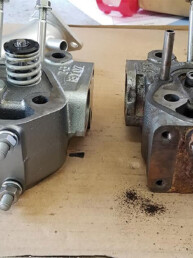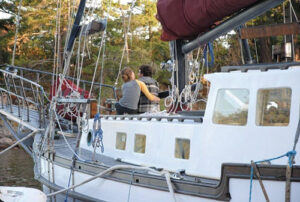
My boyfriend Trevor and I recently finished a huge refit on my boat… or so we thought. We installed a new water tank, re-wired all the electrical systems, spruced up the mast and boom — the list went on and on. I was feeling incredibly proud of how far my formerly derelict, diamond-in-the-rough Hecate had come.
Hecate is a 28-foot Pearson Triton: a fiberglass sloop designed by Carl Alberg that made its debut in 1958. She has the stability of a full lead keel, and the strength of a thick fiberglass hull, which is resistant to warping, cracking, and other damage. I find Hecate to be a shining example of the adage, “they just don’t build ’em like they used to.” However, this can be a double-edged sword.
With my boat back in the water ready for adventure, Trevor and I were rafted together on our respective vessels in my homeport of Pender Harbour, British Columbia. We decided to take Hecate out for a spin around Pender’s large, maze-like waterways, choosing it over Trevor’s boat, which is very large and can be somewhat tricky to maneuver in tight spaces. Hecate is the kind of boat that rolls when you cross the deck from port to starboard. We untied and shoved off from his boat with one foot. Trevor had the tiller and I began unfurling the headsail. It was the first time we’d taken my boat sailing together. After all the work we’d put in and the new equipment I’d acquired, I couldn’t have been more excited. The roller furler was newly installed and I had a new mainsail — everything was going to be great.
A strong gust of wind came through, and there wasn’t time to raise the main before the puff sent us shooting forward under jib alone, toward a raft of derelict fish boats near the shore. The winds in Pender Harbour swirl around the islands, small inlets, and bays, and can be unpredictably tricky. We had just avoided the raft of fish boats when I looked back towards the cockpit and saw Trevor frowning and muttering.
“What’s that?” I asked, smiling.
“This boat doesn’t steer for shit!” exclaimed Trevor.

“What?” I gasped, gobsmacked by the smack talk. We didn’t have much time to argue, though, as we were being pushed toward the leeshore. We tried a few unsuccessful tacks, but couldn’t make any headway upwind from the nearby shore and mishmash of anchored and moored boats.
“I’ll start the motor,” I implored, but Trevor wouldn’t hear of it. He prides himself on being an excellent sailor, and was sure we could sail our way out of trouble. Meanwhile, one of my winches seized, revealing that even after a major refit, Hecate was still a work in progress. Eventually, we made progress away from the shore and, when we were a reassuring distance from the rocks, we started the outboard motor and returned to his boat under power.

Alberg designed full-keel cruiser for the shape of her new rudder.
Once we were safely rafted and the headsail was furled, we got into the what-was-that-all-about debrief. Though the boat would have clearly been more balanced and made better way upwind with the mainsail up and trimmed, Trevor repeated, with slightly less inflammatory phrasing, that my boat doesn’t steer well. My mind flashed back to memories of early dockings, when I had sailed and motored my boat alone, all the way from Lund to Victoria, over the course of about a month of weekends. I could remember getting Hecate close enough to the dock and then flinging myself the meter-plus on to the dock, line clutched in my sweating hand, praying I wouldn’t slip and hurt myself on the occasionally algae-slimed wharves. I’d chalked up my difficulties to my inexperience, but maybe it was also true that the boat didn’t steer well.

A rudder is a critical, though inherently vulnerable, element of a boat’s design. Steering oars predated them, but transom-hung rudders first appeared in China during the Han dynasty about 1,800 years ago. This design still exists today, and for good reason, they are easier to build and repair than the majority of modern rudders, whose rudder posts come up through the bottom of the boat directly into the cockpit. Hecate has the more modern style of rudder with its underwater attachment. It is a full keel rudder, connected through pintles and gudgeons at two points to the back of the keel, which is in contrast to “spade rudders” which only connect to the boat through the shaft and are most often found on fin keel boats.
The shape of full-keel rudders has changed over the years, improving their steering capabilities. Hecate, built by Pearson Yachts in the 1960s, has a diminutive, curved rudder, reminiscent of a human ear. It has a hole in the center where the propeller blade would turn if I hadn’t previously removed the worn-out Atomic 4 inboard engine and hammered a wooden plug into the stern tube.
Only a few years after Hecate was built, Pearson began outfitting their boats with fuller, more rectangular-shaped rudders. Naval architects had discovered that the majority of a rudder’s steering power came from its bottom-third — the part that had been elegantly slimmed down on my boat. To make matters worse, the prop aperture, cutting half into my rudder and half into my hull, was an entirely useless vestigial limb that further reduced the rudder’s surface area.
Trevor suggested that we replace it sometime in the future, when I did my next haul out. I hesitantly agreed, fearing a little for the effort and expense that was sure to come with a new rudder. In the end, however, thanks to Trevor’s kindness and good sense, Hecate’s rudder refit would cost me hardly anything.
Over the next few months, the idea of replacing the rudder entirely would occasionally surface, and we’d even discuss asking a naval architect to draft the dimensions for one. Ultimately, that idea was scrapped; we didn’t have the time, energy, or money for that.
Instead, Trevor came up with an alternative option that would improve steerage for the time being, reduce fail points, and not take much time or money, allowing us to save up reserves to someday replace the rudder, post, and all. Given the visible pink corrosion on the bronze shaft, this would definitely be a good thing to do.
In the meantime, Trevor proposed sandwiching the existing rudder in two sheets of ¼ inch marine-grade plywood marinated in epoxy-saturated fiberglass cloth. The plywood would be cut, in mirror images, to the shape of the desired rudder. For inspiration, we strolled around Jack’s Boat Yard, checking out the rudders on the hard, conveniently at eye-level. There happened to be a comparable Carl Alberg design just kitty-corner to me, with a more modern “rectangular” rudder. Standing with my hands on my hips, it was approximately the shape of my bent arm with a point at my elbow. We had our plan.
When we began the project in earnest, the first order of business was to have Trevor fill in my old propeller aperture on the hull with foam insulation smothered in epoxy and wrapped in fiberglass. Then, we took some skinny strips of door skin, plugged in the glue gun, and glued the ends of the strips together in the shape of my current rudder, plus a beefed-up trailing edge and fuller bottom-third. Next, we laid the template on the plywood and used a jigsaw to cut it out.
Then came the permanent changes. We sanded the rudder, smothered it in thickened epoxy, and smooshed the plywood onto either side, over top of the worn-looking gudgeons, smooshing the remaining thickened epoxy in the trailing edge, between the plywood. We twisted many clamps onto the trailing edge to keep it in shape and in place while the epoxy hardened, before sanding, fiberglassing, and reapplying bottom paint.
I’m very proud of our ingenuity and effort with the new rudder, which steers beautifully. We know that our rudder refit has some compromises, from potentially overloading the gudgeons to simply increasing drag with a larger, wider foil. Yet for me, it’s an elegant short-term solution, and the increased steering performance has brought more confidence along with it.

The handling improvement came just in the nick of time. Shortly after the completion of the project, when motoring back to Pender Harbour with my mother, I was compelled to do my trickiest docking yet. My mother’s longtime friends, Nick and Celia, were spending the night on their motorboat Okey Doke, which was tied to their friend’s dock on Hardy Island. They had invited us to spend the night on the dock with them. We had received some instructions from Celia, but eventually it came down to Nick standing on the point of a bluff and waving his arms. Figuring that the dock must be around that point, I turned the tiller (bliss!) and veered efficiently around the bluff. I was met not with a little bay, but with a crack in a cliff. A tiny dock, only the length of a modestly proportioned boat, was wedged in the middle of that crack. Okey Doke was already on the “good side”— that is, the side with more than 10 feet between the dock and the rocky shoreline, but not much more. I considered throwing the motor into reverse, but continued bravely forward, trusting our friends and my boat. I threw down the fenders and slowly motored in, steering my little boat with its 8-foot beam into that crack between a literal “rock and a hard place.”
“Avoid the rocks!” Celia hollered, helpfully I suppose, as the dock was the softer of the two. Against my own doubts and past experiences, I was able to successfully glide the boat into its coffin-like slip without hitting anything, and calmly pass our friends the bow and stern lines.
My do-it-yourself rudder refit has done wonders for Hecate’s steering, and has made my overall sailing experience much better. Bit by bit, I’m sailing my classic boat into the future.
Emma Biron lives in Pender Harbour, BC, and can often be seen sailing her Pearson Triton 28 around the harbour and beyond. In addition to sailing, she also loves reading, writing, refits, and rowing.
Emma Biron
Emma Biron lives in Pender Harbour, BC, and can often be seen sailing her Pearson Triton 28 around the harbour and beyond. In addition to sailing, she also loves reading, writing, refits, and rowing.

